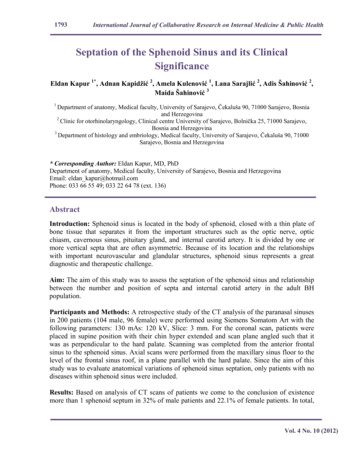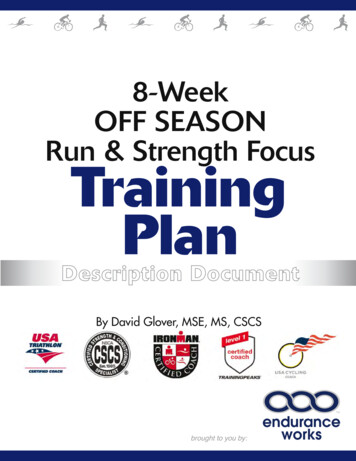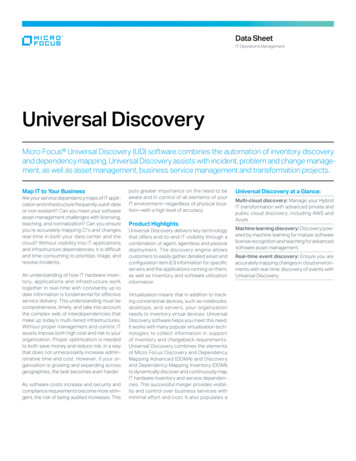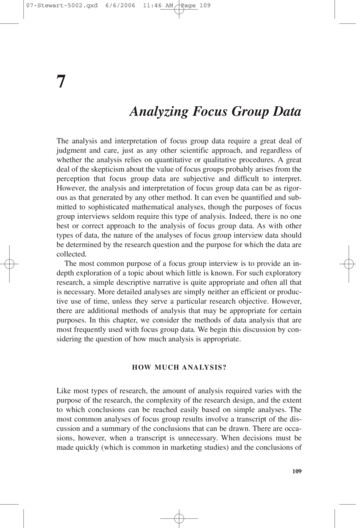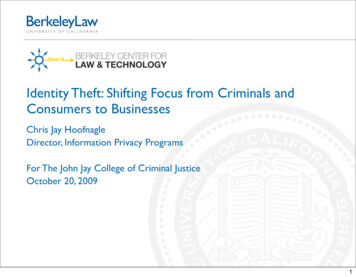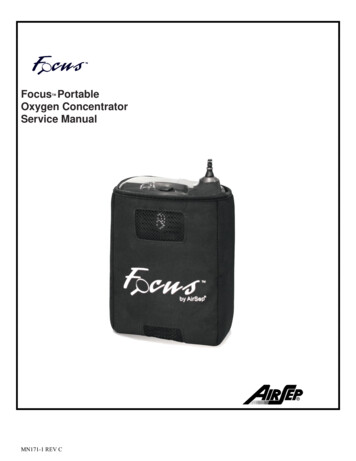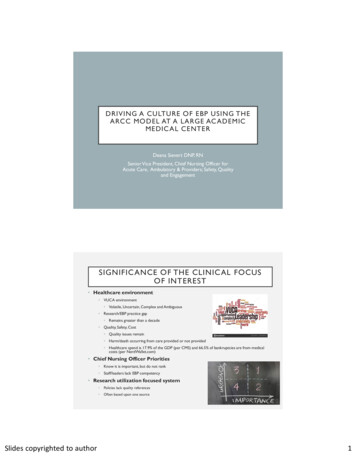
Transcription
DRIVING A CULTURE OF EBP USING THEARCC MODEL AT A LARGE AC ADEMICMEDIC AL CENTERDeana Sievert DNP, RNSenior Vice President, Chief Nursing Officer forAcute Care, Ambulatory & Providers; Safety, Qualityand EngagementSIGNIFIC ANCE OF THE CLINIC AL FOCUSOF INTEREST Healthcare environment VUCA environment Volatile, Uncertain, Complex and Ambiguous Research/EBP practice gap Remains greater than a decade Quality, Safety, Cost Quality issues remain Harm/death occurring from care provided or not provided Healthcare spend is 17.9% of the GDP (per CMS) and 66.5% of bankruptcies are from medicalcosts (per NerdWallet.com) Chief Nursing Officer Priorities Know it is important, but do not rankin as a top priority Staff/leaders lack EBP competency Research utilization focused systemSlides copyrighted to author Policies lack quality references Often based upon one source1
PICOT IN THE BEGINNING PURPOSE IN THEEND PICOT In acute care hospitals (P), how does identifying and implementing a selected EBPmodel/framework (I) compared to not using an EBP model/framework (C) affectorganizational culture acceptance and utilization of EBP (O)? Purpose of the EBP quality improvement project The purpose of this project is to a) infuse into the culture of selected organizational unitsthrough use of the ARCC model an appreciation and acceptance of EBP that b) leads toutilization and implementation of EBP to guide practice and c) improvement in associatedoutcomes of beliefs, utilization and organization culture readiness.SIGNIFIC ANCE TO NURSING One of the largest work forces in healthcare IOM quadruple aim National Database of Nursing Quality Indicators Part of our code of ethics and nurse practice acts Required to continue to contribute to knowledgeSlides copyrighted to author2
THEORETIC AL FRAMEWORK/MODEL Three theoretical frameworks/models will be used and built upon each other Abdellah’s 21 Nursing Problems Theory Lewin’s Change Theory Advancing Research and Clinical Practice through Close Collaboration (ARCC) modelA B D E L L A H ’ S S T E P S A N D N U R S I N G AC T I O N S T E P SW I T H I N T H E S TA G E S O F L E W I N ’ S C H A N G E T H E O RYUnfreezingProblem Identification: Learn to know the patient (staff); Sort out relevant and significant data; Make generalizationsabout available data in relation to similar nursing (organizational) problems; Identify the therapeutic planNursing Actions.Observation of health status and skills of communicationPlanning, organizing work, use of resource materials and personnel resourcesTherapeutic use of self and nursing procedureChangeProblems Identification. Test generalizations with the patient (staff) and make additional generalizations; Validate thepatient’s (staff’s) conclusions about his nursing problems; Observe and evaluate over a period of time to identify anyattitudes and clues affecting his behavior; Explore the patient (staff) and family (team) reaction to the therapeutic plan andinvolve them in planNursing Action.All of those used for the Unfreezing stageApplication of knowledgeTeaching of patients (staff) and families (teams) and directing the work of othersRefreezingProblem Identification. Identify how the nurses feel about the patient’s (organizational) nursing problems; Discuss anddevelop a comprehensive nursing care plan (organizational plan); Continue to cycle through all of the steps periodicallythroughout this stage of the project for validationNursing Action.Slides copyrighted to authorContinue to use all of the actions throughout this stage of the project.3
EBP MODEL: ARCCREVIEW OF THE LITERATURE First article (Flodgren et al., 2012) is a systematicreview. No determinations offered except that itappeared organizational infrastructure doespromote EBP in the single study. Second article (Fineout-Overholt et al, 2005) is aRCT. Did not provide quality, statistically significantevidence but did provide clinical value related tothe PICOT.Slides copyrighted to author4
REVIEW OF THE LITERATURE Third article (Friesen et al., 2017) is a cohort study.Statistical improvement of EBP utilization at the bedsideand of organizational acceptance of EBP. Fourth article (Beckenridge-Sproat et al., 2015) is acohort study. Statistical improvement of EBP utilizationat the bedside, improved staff beliefs of EBP andorganizational acceptance of EBP.REVIEW OF THE LITERATURE Fifth article (Melnyk et al., 2017) is a cohort study. Statistical improvement ofEBP utilization at the bedside, improved staff beliefs of EBP and organizationalacceptance of EBP. This study also resulted in statistical improvement in patientoutcomes. Sixth article (Hanrahan et al., 2015) is a descriptive study. Statisticalimprovement of EBP utilization at the bedside and patient outcomes.Slides copyrighted to author5
OUTCOME SYNTHESISIdentifiedarticle/workHanrahan, Fineoutet al.,Overholt,(2015)et al.,(2005)Outcome – Beliefsof EBPOutcome – Use ofEBPOutcome –OrganizationalCultureAcceptance ofEBPOutcome –Patient OutcomesFriesen Breckenridge- Melnyk,, et al., Sprout et al., et al.,(2017) (2015)(2017)Nochange Flodgren,et al.,(2012) Nochange NochangeRECOMMENDATION: SYNTHESIS OF EVIDENCE Substantial support indicating that utilizing an EBP model toshift organizational culture to one that is accepting of andwilling to use EBP is a best practice. Upon further review of different models, there are specificmodels that work better for organizational change. TheARCC model is one that works well for organizationalchange.Slides copyrighted to author6
PROJECT OVERSIGHT Proposed project was designated an EBP QualityImprovement project The methods and implementation are not consideredresearch. Therefore, did not require protection of humansubjects. Did NOT require IRBPROJECT GOALS Identify status of the organizational infrastructure to provide support for EBP initiatives Design and support programs and initiatives, not currently in existence that provideorganizational infrastructure for EBP Increase the identified nursing staffs’ and the nursing leaders’ beliefs surrounding EBP Inspire a culture of inquiry Create a team of EBP mentors Specifically see an improvement in EBP beliefs and perceptions of organizationalreadiness. Set a path for increasing staff nurse utilization of EBPSlides copyrighted to author7
PRACTICE SETTING Large metropolitan, tertiary facility Level I adult trauma center, Level II pediatric trauma center, Comprehensive Stroke Center Bariatric Center of Excellence Three units selected for the project General acute care unit Adult intensive care unit General pediatric acute care unit Eligible participants include all staff nurses from theidentified unitsMETHODS AND MEASUREMENT Sample: 49 nursing leaders trained to be EBP mentors and 28 staff who toolthe pre and post intervention surveys. Intervention: 8 weeks of EBP mentor sessions and optional online modules. Measurement: The 3 survey tools were combined into a single survey threadin JotForm and delivered through organizational email. Baseline survey open 2 weeks Post survey open for 2 weeks using same process and incentive. Incentives: A raffled incentive was provided at the unitlevel for increased participation. Analysis: Outcomes data described anddependent group t-test conductedSlides copyrighted to author8
MEASUREMENT TOOLS Organizational Culture and Readiness for SystemWide Integration of Evidence-Based Practice Survey(OCRSIEP) 25 item survey that identifies questions that help assess the organizational culture inrelation to EBP. Participant assigns an answer similar to a Likert scale Evidence-Based Practice Beliefs Scale 16 item survey that identifies the individual beliefs about EBP. Participant assigns an answer similar to a Likert scale Evidence-Based Practice Implementation Scale 18 item survey that identifies how often in the past 8 weeks were any of the EBPsteps used.TOOLS FOR THE EBP MENTORSSlides copyrighted to author9
TOOLS FOR THE EBP MENTORSRESULTS: ORGANIZATIONAL CULTURE ANDREADINESS (ORCSIEP) Outcomes resulted in 7 of the 25 questions moved in a positive direction and werestatistically significant (p 0.05). 3 questions re: if EBP champions exist in the environment among physicians, nurseeducators and APRNs did trend in a negative direction, however were notstatistically significant.Slides copyrighted to author10
RESULTS: ORGANIZATIONALCULTURE AND READINESS(ORCSIEP) (CONT’D) Statistically significant outcomes: EBP is clearly described as central to the organizational mission andphilosophy The extent EBP is practiced in the organization The extent the nursing staff with whom you work are committed toEBP The organization’s administration commitment to EBP A critical mass of nurses in the organization who have strong EBPknowledge and skill The extent practitioners model EBP in the clinical settings The extent there are EBP champions in the environmentRESULTS: BELIEFS (EBP BELIEFS SC ALE) Outcomes resulted in 8 of the 16 questions moving in a positive direction and werestatistically significant (p 0.05). All outcomes did see a positive improvementSlides copyrighted to author11
RESULTS: BELIEFS (EBP BELIEFS SC ALE) Statistically significant outcomes: Believing that EBP results in the best clinical care Being clear about the steps of EBP Being able to implement EBP Being able to overcome the barriers of EBP Believing that implementing EBP will improve the care provided Believing they can access the best resources to implement EBP Being confident about the ability to implement EBP where they work Believing that the care delivered is evidence-basedRESULTS: IMPLEMENTATION (EBPIMPLEMENTATION SC ALE) Outcomes resulted in 3 of the 18 questions improve significantly. Overall, most of the scores moved in a positive direction. There was one thatstayed the same and two that decreased.Slides copyrighted to author12
RESULTS: IMPLEMENTATION (EBPIMPLEMENTATION SC ALE) Statistically significant outcomes: Sharing an evidence-based guideline with a colleague Shared evidence from a research study with apatient/family member Promoted the use of EBP to colleagues. In comparison to the ORCSIEP and Beliefs thatalso use a Likert like scale, the overall scores forthis survey were much lower ranging in the 1-2range, (the lower end of the scale) than theother surveys.RESULTS - AVERAGESSURVEYPOSTPREINTERVENTIO INTERVENTION SCOREN SCORE(AVERAGE)(AVERAGE)RANGE .363.216-80EBPIMPLEMENTATION3438.50-72Slides copyrighted to author13
LIMITATIONS Sample size Unable to determine distribution from units Not having CNS staff and using nursing leaders Not collecting full demographics of participants Peak influenza season Lack of using implementation scienceMETHODS OF DISSEMINATION Participating units – staff and leadership System senior nursing leadership and Chief Nursing Officer meetings Multidisciplinary leadership meetingsSlides copyrighted to author14
DNP ESSENTIALS Essential I – Scientific Underpinnings for Practice Essential II - Organizational and Systems Leadership for Quality Improvement andSystems Thinking Essential III - Clinical Scholarship and Analytical Methods for Evidence-BasedPractice Essential V - Health Care Policy for Advocacy in Health Care Essential VI - Interprofessional Collaboration for Improving Patient and PopulationHealth Outcomes Essential VII - Clinical Prevention and Population Health for Improving theNation’s Health VIII – Advanced Nursing Practice (AACN, 2006).IMPLIC ATIONS A modest investment in training and providing time for staff and leaders topractice EBP can lead to improved beliefs and a stronger organizational culture ofEBP The DNP nursing leader can drive initiatives around culture change using theARCC model to ensure the organizational is providing the right care, at the righttime to the right patients.Slides copyrighted to author15
CONCLUSION/RECOMMENDATIONS ARCC model provided a methodology to improve the culture’s acceptance andbelief in EBP The data helped inform the organization of opportunity for improved structure,orientation, education and mentoring In the future, it will serve as: A strategy to improve the implementation of EBP A strategy to improve safety event rates, improve patient outcomes and contain costs As a proven strategy to roll the work out to the remainder of the organization and thenthe systemDISCUSSION AND DIALOGUE ANDGRATITUDESlides copyrighted to author16
REFERENCES Available upon requestSlides copyrighted to author17
Sep 09, 2020 · Bariatric Center of Excellence Three units selected for the project General acute care unit Adult intensive care unit General pediatric acute care unit Eligible participan
